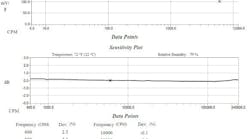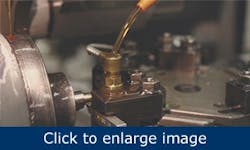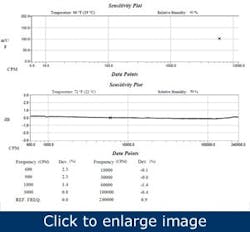Selecting the best accelerometer for a specific predictive maintenance application can be a daunting task, even for the most seasoned walk-around warrior. The process typically can be filtered down to a series of nine qualifying questions. By discovering the answers to the following nine questions, as it applies to your personal application, you’ll be able to find the best vibration monitoring solution.
Question 1: What do you want to measure?
This might seem obvious at first, but stop for a second. What are you actually trying to measure? In other words, what are your goals? What are you expecting to get? What are you going to do with the data? Vibration can be monitored with accelerometers that provide raw vibration data or transmitters that provide the calculated overall root mean square (RMS) vibration. Analysts find raw vibration readings to be useful because it contains all the information in the vibration signal, the true peak amplitudes and vibration frequencies. The overall RMS or peak values are useful in control systems such as PLC, DCS, SCADA and PI because of their continuous 4-20 mA signal. Some applications use both. By determining which signal variety is required for your application, you can narrow your search significantly. Also, are you measuring vibration in terms of acceleration, velocity or displacement? Have you considered that some industrial sensors can output temperature along with vibration? Lastly, some applications, such as vertical pumps, ideally are monitored in more than one vibration axis. Does your application require uniaxial, biaxial or triaxial measurement?
Question 2: What is the vibration amplitude?
The maximum amplitude or range of the vibration being measured determines the sensor range that can be used. Typical accelerometers sensitivities are 100 mV/g for a standard application (50 g range) and 500 mV/g for a low-frequency or low-amplitude application (10 g range). General industrial applications with 4-20 mA transmitters commonly use a range of 0-1 in/s or 0-2 in/s.
Question 3: What is the vibration frequency?
[pullquote]Physical structures and dynamic systems respond differently to varying excitation frequencies. A vibration sensor is no different. Piezoelectric materials, by nature, act as high pass filters and as a result, even the best piezoelectric sensor will have a low-frequency limit near 0.2 Hz. A sensor that acts as a dynamic system with one degree of freedom exhibits natural frequencies. The signal is greatly amplified at the natural frequency, leading to significant change in sensitivity and possible saturation. Most industrial accelerometers have single- or double-pole RC filters to combat saturation excitation at the resonant frequency. It’s critical to select a sensor with a usable frequency range that includes every frequency you’re interested in measuring.
Question 4: What is the environment temperature?
Applications with extremely high temperatures can pose a threat to the electronics built into accelerometers and 4-20 mA transmitters. Charge-mode accelerometers are available for use in very high temperature applications. These have no built-in electronics, but instead have remote charge amplifiers. Charge-mode accelerometers with integral hard-line cable are available for applications hotter than 500° F, such as gas turbine vibration monitoring.
Question 5: Will it be submersed in liquid?
Industrial accelerometers with integral polyurethane cable are completely submersible in liquid for permanent installation. For high-pressure applications, it’s a good idea to test the sensors at pressure for one hour. Applications requiring complete submersion need integral cable. Integral cable is normally required as well if the application is sprayed rather than being completely submersed, such as cutting fluid on machine tools.
Question 6: Will it be exposed to potentially harmful chemicals or debris?
Industrial accelerometers can be constructed with corrosion- and chemical-resistant stainless steel bodies. Consider using PTFE cable with corrosion-resistant boot connectors if your application is in an environment with harmful chemicals. It’s strongly recommended that you check a chemical compatibility chart for any suspect chemicals. Integral armor-jacketed cables offer excellent protection for cables that might come into contact with debris such as cutting chips or workers’ tools.
Question 7: Do you need a top exit, side exit or a low profile connection?
Ultimately, the sensor will need to be installed on equipment in the space available. Sensor geometry has little effect on its performance, but consider factors such as space available and where a maintenance engineer can operate safely. A low-profile accelerometer (Figure 1) with a locknut design allows them to be oriented in any direction, which can be helpful when working with integral cable.
Figure 1. This is an example of a low-profile accelerometer with a side connection to jacketed cable.
Question 8: Should you use a precision or low-cost sensor?
There are two main differences between low-cost and precision accelerometers. First, precision units typically receive a full calibration, that is, the sensitivity response is plotted with respect to the usable frequency range. Low-cost accelerometers receive a single-point calibration and the sensitivity is shown only at a single frequency. Second, precision accelerometers have tighter tolerances on some specifications such as sensitivity and frequency range.
For example, a precision accelerometer might have a nominal sensitivity of 100 mV/g ± 5% (95 mV/g to 105 mV/g) (Figure 2) while a low-cost accelerometer might have a sensitivity of 100 mV/g ± 10% (90 mV/g to 110 mV/g). Customers with data acquisition systems often will normalize the inputs with respect to the calibrated sensitivity. This allows a group of low-cost sensors to provide accurate, repeatable data. Regarding frequency, a precision accelerometer typically has frequency ranges in which the maximum deviation is 5% while low-cost sensors might offer a 3 dB frequency band. Even so, a low-cost sensor might offer excellent frequency response.
Comparison of calibration data for a low cost (top) and precision (bottom) accelerometer.
Figure 2. The upper plot corresponds to a low-cost accelerometer that was calibrated at one point, while the lower plot, with its continuous calibration line, corresponds to a higher-cost unit.
Question 9: Do you need special approvals?
Accelerometers and 4-20 mA transmitters are both available with CSA and ATEX approvals for use in hazardous areas. Compare the type of approval needed with the sensor’s published approvals to ensure it meets your needs.
The answers to these nine questions can greatly narrow your search to the best solution for the application. Keep in mind, some combination of answers might be mutually exclusive, that is, a solution for each criteria doesn’t exist. For example, a particular model might not carry the proper ATEX certification for your hazardous area application. Additionally, specialized applications might have other considerations.
Frank Pereny, BSME, is an application engineer for IMI Sensors (www.imi-sensors.com). He can be reached at [email protected] and (800) 959-4464.


